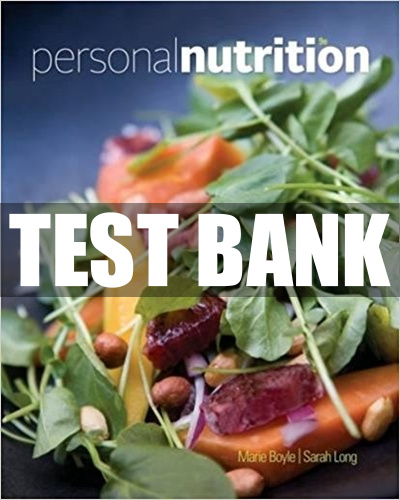Test Bank For Personal Nutrition 9th Edition by Marie A. Boyle
Original price was: $75.00.$45.00Current price is: $45.00.
Test Bank For Personal Nutrition 9th Edition By Marie A. Boyle is one of the most comprehensive and well-rounded nutrition textbooks available on the market today. It covers all of the major food groups and nutrients and provides detailed information on how they impact our health.
The book also includes a variety of helpful tools, such as a nutrient tracker and meal planner. Perhaps most importantly, Test Bank For Personal Nutrition 9th Edition By Marie A. Boyle is written in an engaging and accessible style that makes it easy for students to understand and apply the concepts covered. If you are looking for a top-notch nutrition textbook, Test Bank For Personal Nutrition 9th Edition By Marie A. Boyle is an excellent choice.
Digital item No Waiting Time Instant Download
ISBN-13: 978-1305110427 ISBN-10: 1305110420
Description
Test Bank For Personal Nutrition 9th Edition by Marie A. Boyle
Chapter 04 – The Carbohydrates – Sugar – Starch – and Fiber
True / False
1. The primary role of fiber in the diet is to provide quick energy.
a. True
b. False
ANSWER: False
DIFFICULTY: Understand
REFERENCES: 4.3 The Complex Carbohydrates: Starch and Fibers
LEARNING OBJECTIVES: PNUT.BOYL.16.4.3 – Describe the health benefits associated with complex carbohydrates, including the two major types of dietary fibers.
2. Babies develop the ability to digest lactose when they are about six to nine months old.
a. True
b. False
ANSWER: False
DIFFICULTY: Understand
REFERENCES: 4.2 The Simple Carbohydrates: Monosaccharides and Disaccharides
LEARNING OBJECTIVES: PNUT.BOYL.16.4.2 – Identify major food sources of the monosaccharides, disaccharides, and polysaccharides common in nutrition.
3. Soluble fibers help lower blood cholesterol levels.
a. True
b. False
ANSWER: True
DIFFICULTY: Remember
REFERENCES: 4.3 The Complex Carbohydrates: Starch and Fibers
LEARNING OBJECTIVES: PNUT.BOYL.16.4.3 – Describe the health benefits associated with complex carbohydrates, including the two major types of dietary fibers.
4. Fat is used efficiently as fuel by the brain and nerves.
a. True
b. False
ANSWER: False
DIFFICULTY: Remember
REFERENCES: 4.1 Carbohydrate Basics
LEARNING OBJECTIVES: PNUT.BOYL.16.4.1 – Describe how carbohydrates are used in the body.
5. People on weight-loss regimens should avoid high-carbohydrate foods.
a. True
b. False
ANSWER: False
DIFFICULTY: Understand
REFERENCES: 4.1 Carbohydrate Basics
LEARNING OBJECTIVES: PNUT.BOYL.16.4.1 – Describe how carbohydrates are used in the body.
6. Carbohydrate digestion begins in the mouth.
a. True
b. False
ANSWER: True
DIFFICULTY: Remember
REFERENCES: 4.5 How the Body Handles Carbohydrates
LEARNING OBJECTIVES: PNUT.BOYL.16.4.5 – Summarize carbohydrate digestion and explain how the body maintains a normal blood glucose level.
7. Carbohydrate-rich foods are obtained almost exclusively from plants.
a. True
b. False
ANSWER: True
DIFFICULTY: Remember
REFERENCES: 4.1 Carbohydrate Basics
LEARNING OBJECTIVES: PNUT.BOYL.16.4.1 – Describe how carbohydrates are used in the body.
8. The body’s form of stored glucose is called glucagon.
a. True
b. False
ANSWER: False
DIFFICULTY: Remember
REFERENCES: 4.5 How the Body Handles Carbohydrates
LEARNING OBJECTIVES: PNUT.BOYL.16.4.5 – Summarize carbohydrate digestion and explain how the body maintains a normal blood glucose level.
9. The protein in a meal stimulates glycogen secretion, which opposes insulin and prevents it from storing glucose.
a. True
b. False
ANSWER: False
DIFFICULTY: Remember
REFERENCES: 4.5 How the Body Handles Carbohydrates
LEARNING OBJECTIVES: PNUT.BOYL.16.4.5 – Summarize carbohydrate digestion and explain how the body maintains a normal blood glucose level.
10. People with hypoglycemia should eat several snacks throughout the day that are high in simple sugars.
a. True
b. False
ANSWER: False
DIFFICULTY: Understand
REFERENCES: 4.6 Hypoglycemia and Diabetes
LEARNING OBJECTIVES: PNUT.BOYL.16.4.6 – Differentiate between type 1 and type 2 diabetes, including risk factors for each.
11. Adding foods sweetened with sugar substitutes to the diet will ensure successful weight loss.
a. True
b. False
ANSWER: False
DIFFICULTY: Understand
REFERENCES: 4.8 Spotlight: Sweet Talk-Alternatives to Sugar
LEARNING OBJECTIVES: PNUT.BOYL.16.4.8 – List examples of alternatives sweeteners approved for use in the diet.
Multiple Choice
12. If a person uses up his or her reserve supply of glycogen and still does not eat, sugar will come from the ____ to provide fuel for the brain.
a. heart
b. liver
c. bloodstream
d. muscle
e. kidneys
ANSWER: d
DIFFICULTY: Remember
REFERENCES: 4.6 Hypoglycemia and Diabetes
LEARNING OBJECTIVES: PNUT.BOYL.16.4.6 – Differentiate between type 1 and type 2 diabetes, including risk factors for each.
13. What hormone lowers high levels of glucose in the blood?
a. glycogen
b. insulin
c. norepinephrine
d. adrenaline
e. dopamine
ANSWER: b
DIFFICULTY: Remember
REFERENCES: 4.5 How the Body Handles Carbohydrates
LEARNING OBJECTIVES: PNUT.BOYL.16.4.5 – Summarize carbohydrate digestion and explain how the body maintains a normal blood glucose level.
14. What is another name for low blood glucose?
a. hyperglycemia
b. depression
c. hypoglycemia
d. dysphoria
e. nephritis
ANSWER: c
DIFFICULTY: Remember
REFERENCES: 4.6 Hypoglycemia and Diabetes
LEARNING OBJECTIVES: PNUT.BOYL.16.4.6 – Differentiate between type 1 and type 2 diabetes, including risk factors for each.





Be the first to review “Test Bank For Personal Nutrition 9th Edition by Marie A. Boyle”